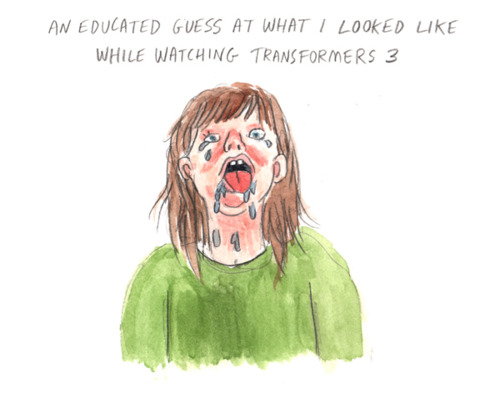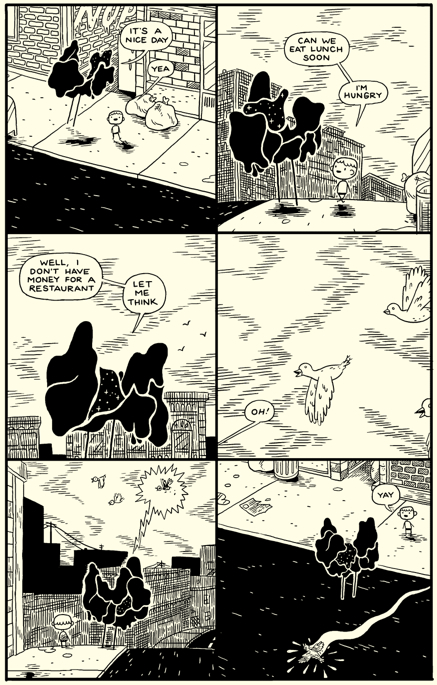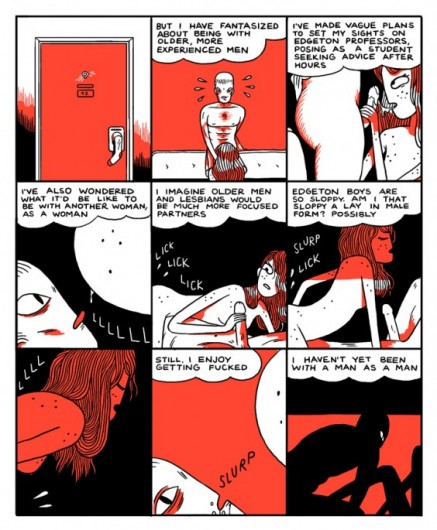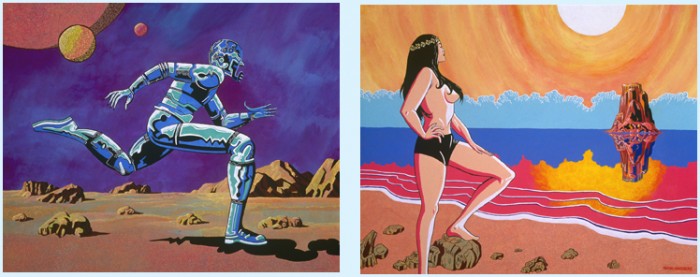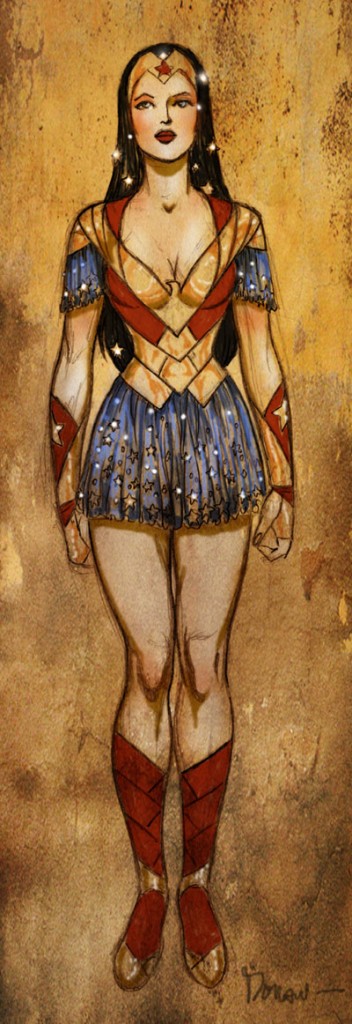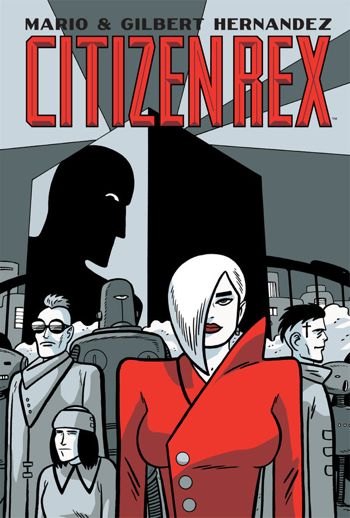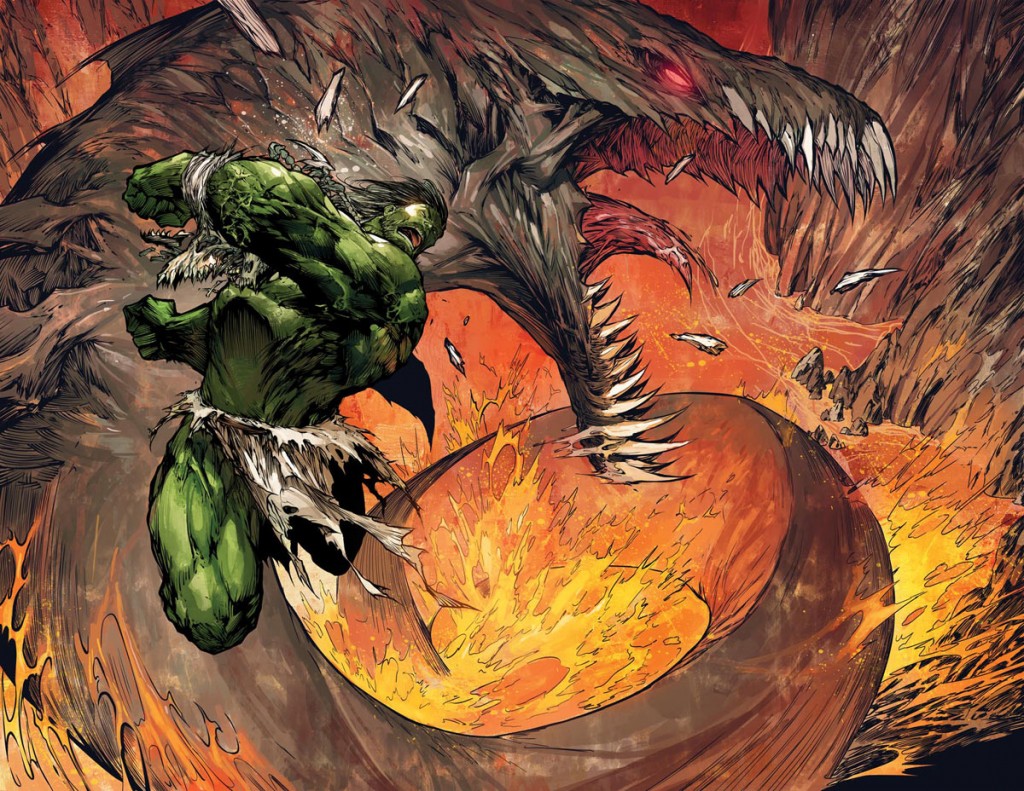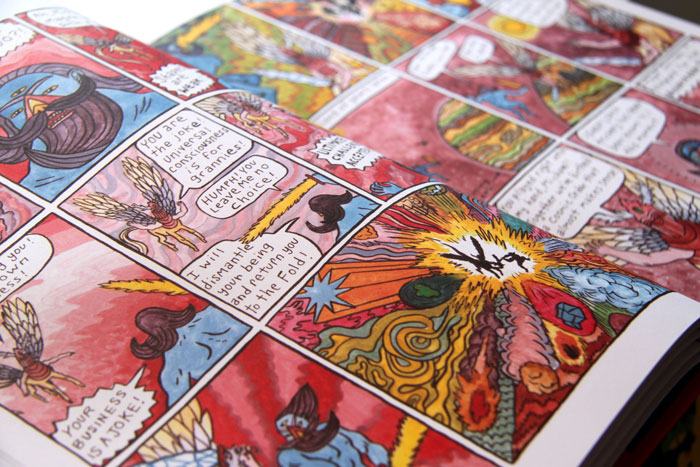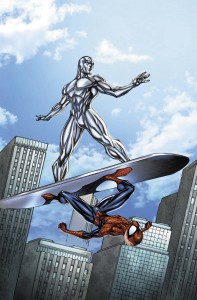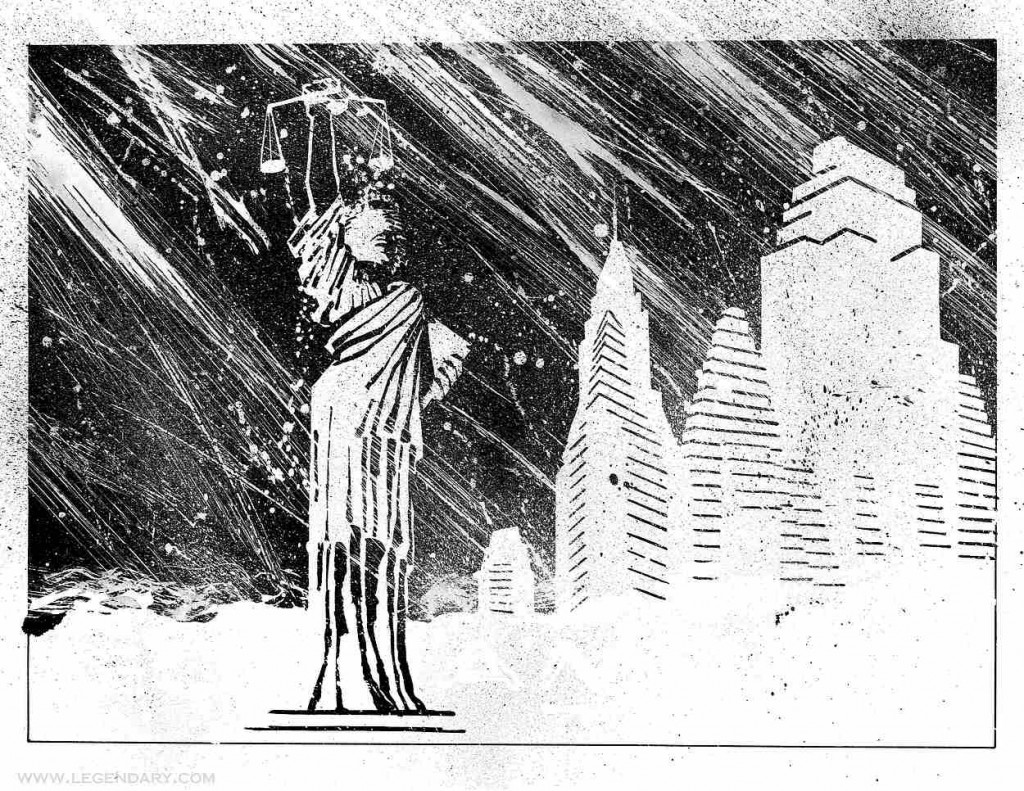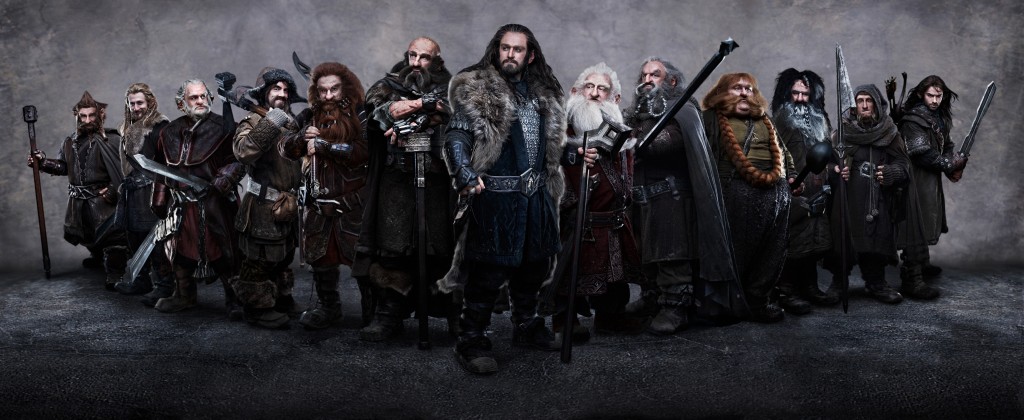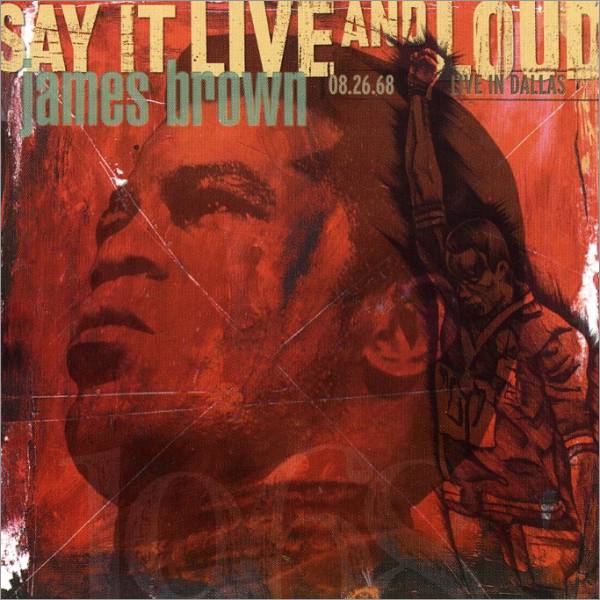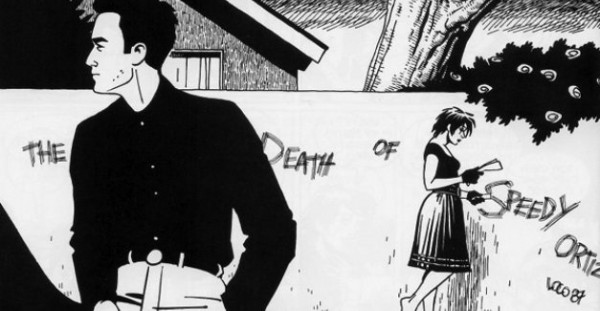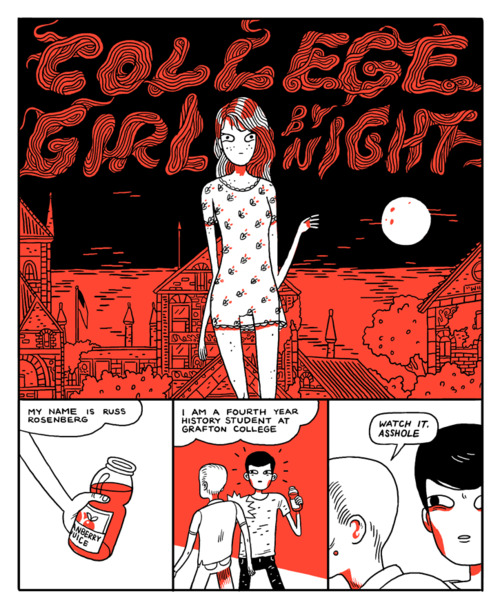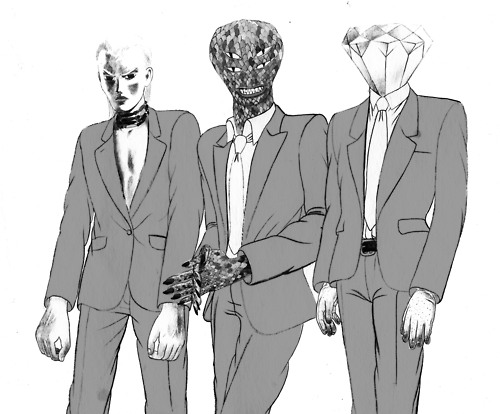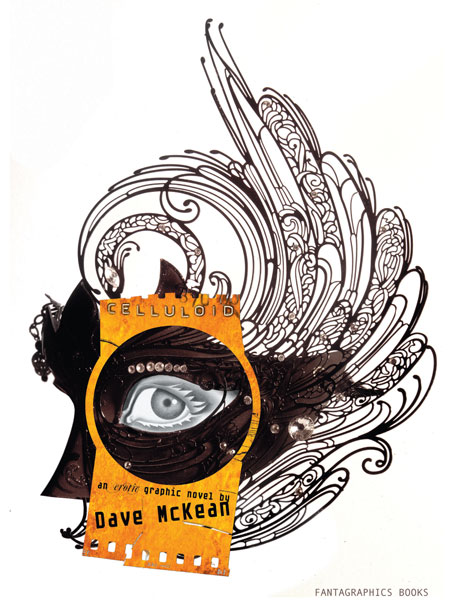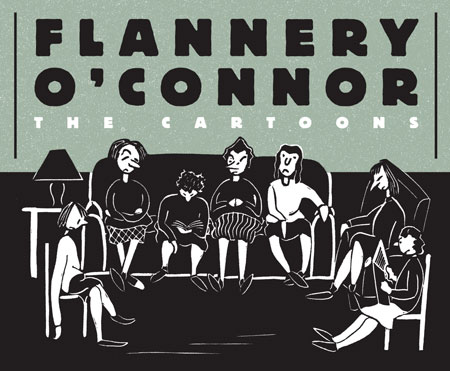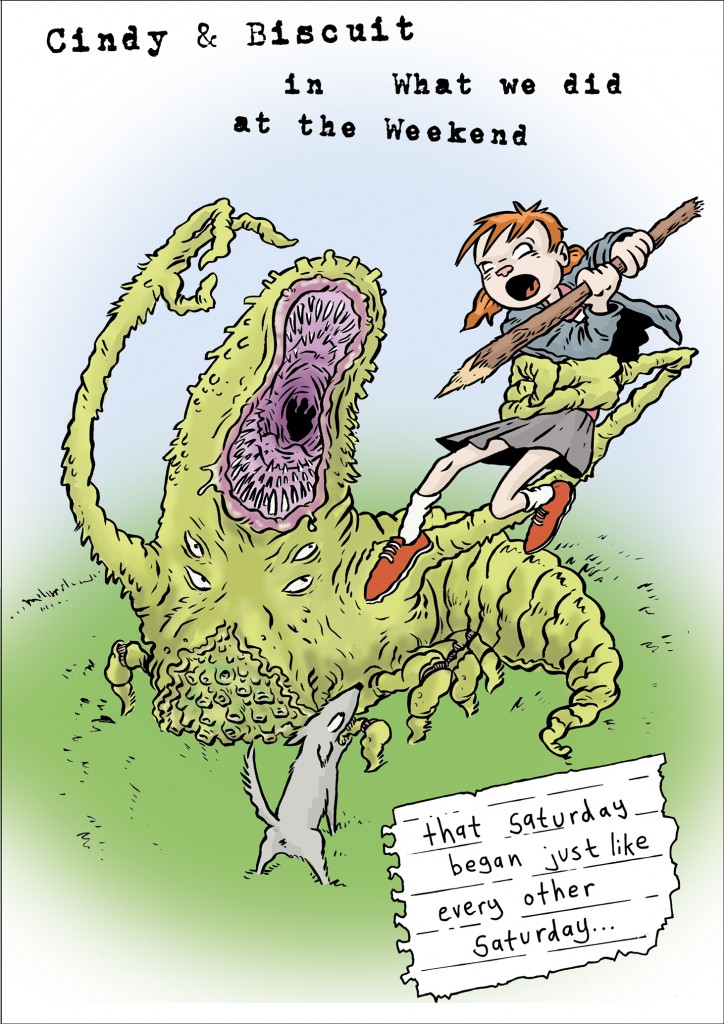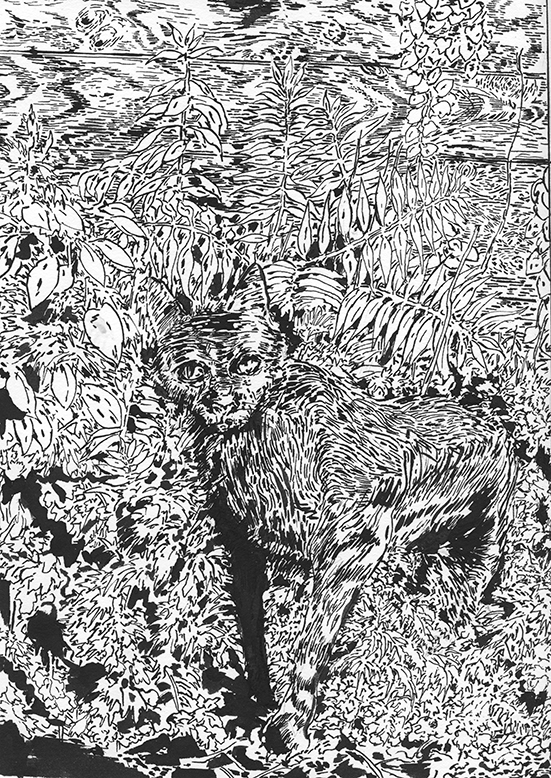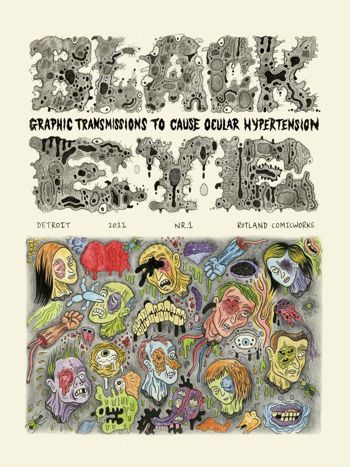Archive for July 30, 2011
Carnival of souls: DC, DeForge, HBO execs on Game of Thrones, more
July 30, 2011* I’m impressed by DC’s response to the recent debate over the number of women creators it employs. Anyone who says “Well they had to say something, it was bad PR” has obviously not been following the comics industry very long. When you ask someone publicly to do something, and they say “You’re right, we’ll try to do better on that,” that’s a really good thing, especially on an issue like this. Good for DC.
* Grant Morrison in conversation with Neil Gaiman. A fun quote from Gaiman about Morrison: “Whenever I see you now, you are this glorious bird of paradise, but I remember, just as for you I will always be a nervous, hungry young journalist, I remember you as a kid in a black raincoat, incredibly shy. The thing that would get you animated was the point where you’d start talking about a story, and you would come to life.”
* There’s a Marvel/Gary Friedrich lawsuit going on over Ghost Rider right now as well.
* It’s always fun and informative to hear Tom Brevoort talk about how the sausage gets made.
* HBO execs talked about Game of Thrones in a reasonably interesting fashion recently: They’re standing very firm on the 10-episodes-per-season issue, which is unfortunate, but other than that they seem very supportive of a long run and not apt to try to cram too much material (i.e. the entirety of the fatter volumes) into a single season as opposed to spreading it out.
* RoboCop vs. Transformers vs. Hanawalt vs. Harbin.
* Uno Moralez is really one of the best.
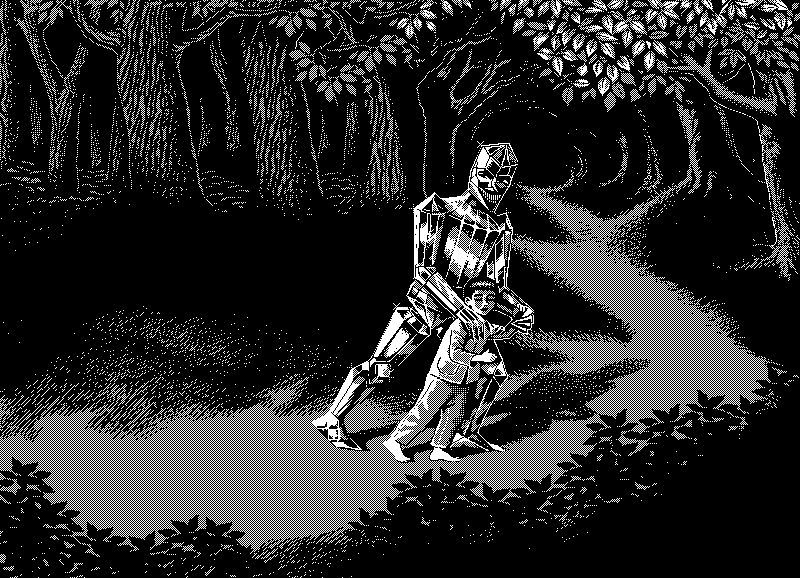
* Funny stuff and sexy stuff from Michael DeForge.
* The Sylvester Stallone Character Name Generator made me laugh very hard. (Via Mike Barthel.)
Carnival of souls: Marvel wins Kirby lawsuit, Beto’s going back to Palomar, Jordan Crane’s new book, more
July 28, 2011* Jack Kirby’s heirs have lost their copyright suit against Marvel, which centered on whether or not Kirby’s creations/co-creations for the company constituted work for hire. The judge ruled that they did: “If it does [constitute work for hire], then Marvel owns the copyright in the Kirby Works, whether that is ‘fair’ or not.” One of the few nice things you can say about “nerd court” is that in nerd court you can concentrate on whether or not a thing is fair. Anyway, in the real world it’s not clear to me whether this is something that can now go to a higher court or whether this settles the matter.
* Recently on Robot 6:
* Gilbert Hernandez will be returning to Palomar with a story in Love and Rockets: New Stories #5, out next year. That surprised me, given his recently expressed feelings about his Palomar material, but I’m as happy about this as I am about any new Beto comics.
* Jordan Crane’s new kids’ book Keep Our Secrets uses heat-sensitive color-changing ink to reveal hidden images. Jordan Crane is pretty amazing, basically.
* Listen to an audio clip of Dan DiDio addressing the number of women creators at DC right now. Check out Laura Hudson’s column on the subject, too. Remember, “We have to stop thinking of it as a quota thing and think of it as a common-sense thing.”
* Marvel is once again offering a variant cover for one of its event comics in exchange for unsold copies of DC’s event comics. Almost everything about this story and all the arguments for and against it is funny to me.
* Grant Morrison spitballs an Atom revamp in which a limit to his size-shifting abilities serves as a parameter for individual adventures. Sure, I’ll eat it.
* The Comic-Con organization’s WonderCon may be moving from San Francisco to Anaheim due to initial scheduling constraints, though as CCI’s David Glanzer tells Tom Spurgeon at the link, it’s far from a done deal because San Fran has changed its mind about the scheduling thing. I hate to see a nice city like San Francisco lose a show, but at the same time you have to imagine that operating a con in Los Angeles itself (more or less) would make a lot of sense for the organization.
* Jeet Heer reviews Ben Katchor’s The Cardboard Valise for the Los Angeles Review of Books. I like that he focuses on the very nearly physical pleasure of reading Katchor comics, as immersive an experience as contemporary comics offers. (Via Tom Spurgeon.)
* J. Caleb Mozzocco’s Robot 6 review of Chester Brown’s Paying For It describes Brown’s appearance in the book as “a grim, expressionless little bobble-headed skeleton…like Harold Grey drawing of the male half of the couple in Grant Wood’s American Gothic.” That’s worth the price of admission for the review right there.
* This is fun: My pal T.J. Dietsch, a total newcomer to the work of Jim Woodring, decided to try Weathercraft. It was a successful experiment. T.J., try Congress of the Animals next!
* I was quite happy to discover Jason Sandberg’s “Kurtzberg” series of paintings at Kirby-Vision, which pay homage to Jack Kirby yet have a static surrealism all their own. You can find more by scrolling through Sandberg’s site.
* Jesus, someone made animated gifs out of Junji Ito’s Uzumaki. Why you do dis to me, Dimmy? Why?
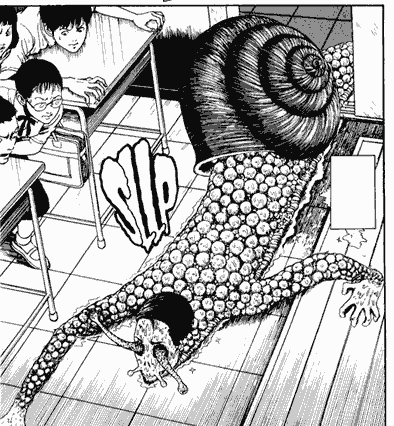
* Finally, I had no idea that there was a dispute over who created my beloved He-Man and the Masters of the Universe. That’s the subject of the documentary Toy Masters, which also chronicles the behind-the-scenes strife between the makers of the television series (J. Michael Straczysnki among them), who saw the job as no different from any artist’s or entertainer’s, and the makers of the toys upon which the show was based, who saw the show as a 30-minute commercial. Errol Morris it ain’t, stylistically speaking, but it’s fascinating if you’re into He-Man and probably still pretty funny if you aren’t. (Via Topless Robot.)
Carnival of souls: Los Bros Hernandez, Jordan Crane, Jonny Negron, more
July 27, 2011* This report on the Gilbert, Jaime, and Mario Hernandez spotlight panel at Comic-Con from CBR’s Sonia Harris makes for fascinating reading. All three brothers are really astute commentators on one another’s work.
* Kevin Czapiewski talks about one of my favorite things about Jordan Crane’s comics: his pictogram sound effects.
* Don’t let Nick Gazin’s short sell in the intro fool you: His interview with Jonny Negron for Vice is fun and informative, and contains a lot of Negron art I haven’t seen to boot.
* Hey, Vasilis Lolos is finally working on a second volume of Last Call! Now whatever happened to The Pirates of Coney Island?
Comics Time: Congress of the Animals
July 27, 2011Congress of the Animals
Jim Woodring, writer/artist
Fantagraphics, June 2011
104 pages, hardcover
$19.99
Buy it and read a preview at Fantagraphics.com
Perhaps I should have seen it coming after the palpable (if fleeting) triumph of good over evil that comprised the climax of Weathercraft, Jim Woodring’s previous standalone graphic novel set in the world of his funny-animal avatar Frank. Regardless, I’ll admit it: I did not expect to read a Frank book whose final panel made me go “Awwww!”
It’s true that in Weathercraft, Frank’s hapless antagonist Manhog achieves enlightenment that for a short while allows him to become an elemental force of kindness, justice, and the security of a fundamentally benevolent order to the universe. But it’s only for a short while — the equilibrium restores itself, and he, the insouciant Frank, and the jauntily predatory Whim go back to their old ways. According to Woodring’s typically dense and hilarious jacket copy, we have the Unifactor, the familiar world of bulbous buildings and shoggoth-like plant deities in which Frank and his cohorts dwell, to thank for this state of affairs. Woodring calls the Unifactor “the closed system of moral algebra into which Frank was born, where “in the end, nothing really changes,” and where “Frank is kept in a state of total ineducability by the unseen forces which control that haunted realm.”
The difference here — and I’m not 100% convinced this would have been clear if Woodring hadn’t said so straight out on the jacket, but be that as it may — is that this time around, Frank leaves the Unifactor. Woodring’s customary Rube Goldbergian plot contrivances force Frank into a state of indentured servitude that ends with him on the lam. The journey positions Frank in the midst of various grown-up concerns, such as home ownership, property loss, commerce, employment, amusement, leisure, sex (in the form of what appears to be an angelic anthropomorphic vagina guarded by the giant disembodied head of a Dr. Seuss character), and religion (in the form of nude, beefy men with gaping chasms where their faces are supposed to be, whose ability to expose their guts at will and induce others to do so literally knocks poor Frank out with its disgustingness and is perhaps Woodring’s most troubling sequence since Manhog flayed his own leg); in other words, it’s a bit like Pippin. Normally we’d expect nothing to come of all this, save for an opportunity to marvel at Woodring’s buzzy, vibrating line, proficiency with creature design, and ability to distill unpleasant shit into slightly sinister slapstick adventures for his dog-cat-bear-mouse-thing hero. But the journey takes Frank so far afield that at some point (probably when he gets lost at sea and washes up on some distant shore) he ends up outside the Unifactor’s confines. New information can now enter his world, in the form of a female Frank-like character who lives in a house shaped like Frank. And at that point all hell breaks loose…which in a Frank comic is to say it doesn’t break loose at all.
Somehow, Frank has gained the ability to interact with another being without immediately sizing up the best way to have fun with, or at the expense of, that being, consequences be damned. They chat. They laugh at the bullying creatures who attacked him earlier, and blush at both having got such a kick out of it. (See, he hasn’t been brushed totally clean of his sins — as we see here and elsewhere, both he and his new pal still have a bit of an empathy deficit.) She protects him from the siren song of that angelic vagina-thing. She helps him return home, to the delight of his pets Pupshaw and Pushpaw, who seem overjoyed to find that their master has found his other half. But what really moved me is their simple physical interaction: They hug. I’m “awwww!”ing just thinking about it. That physical act is an act of grace on Woodring’s part, an escape from the mere hedonism or fight-or-flight responses that have been the sole custom of Frank’s world before now. It’s a new, rewarding emotion, embodied. And despite the break it marks from the world of Frank as we knew it, it fits, since isn’t embodying emotion what Frank stories have always been all about?
Carnival of souls: Fan entitlement, Holy Terror, Supergods, more
July 26, 2011* I posted Tom Brevoort’s comments on fan entitlement on Robot 6, and to my surprise, the ensuing comment thread largely cosigned his statement, as well as similar recent sentiments from Grant Morrison and Bryan Lee O’Malley. I thought about all this stuff today while flipping through Morgan Spurlock and Alba Tull’s surprisingly delightful photo book Comic-Con Episode IV: A Fan’s Hope. The vision of Comic-Con and nerd culture presented in that book is, I’m sure, baffling or even troubling to some comics readers — cosplay, not comics, is its centerpiece; at a glance I’d guess Hollywood personages outnumber comics creators and publishers; and Tull’s portraits of Moto Hagio share a page with her pictures of Gareb Shamus. That said, it’s a picture of Nerd Triumphalism that is, in fact, triumphant. It’s not a bunch of angry, snarky naysayers insulting people and poo-pooing books and movies that haven’t even come out yet — it’s a vibrant, diverse (lots of women, lots of non-white people, lots of kids, even people in wheelchairs) selection of weirdoes, geeks, and creative types, coming together because they’re all excited about the stuff they love. If the people-power aspect of Comic-Con were the public face of nerddom all year round, nerddom would be a lot easier to support, and the crasser, more exploitative mass-marketing aspects of the show would be easier to ignore.
* Frank Miller talks Holy Terror in long-war terms I now find as dispiriting as his increasingly untethered cartooning is invigorating.
* Paul Gravett reviews Grant Morrison’s Supergods, with a focus on whether Morrison’s love of the superhero concept has caused him to undervalue the regular humans responsible for it. (Via Tim Hodler.)
* Dan Conner and Omar are joining the cast of Community. My goodness!
* Wow, Colleen Doran’s concept art for a Wonder Woman costume redesign is lovely.
* “Turtle City” is a deeply cool commission by Theo Ellsworth.
* This assembly of 80 different fan covers of “Black Dog” by Led Zeppelin is almost moving in how well it conveys the simultaneous playfulness and brute force of that almighty riff. (Via Whitney Matheson.)
“Identify yourse—”
July 26, 2011Our real-life-necessitated hiatus is at an end, and page 12 of “Destructor and the Lady” has been posted. You can read the whole story so far in one continuous scroll to refresh your memory, and you can take a peek behind the scenes in Matt Wiegle’s latest process post.
Comics Time: Citizen Rex
July 26, 2011Citizen Rex
Mario Hernandez, writer
Gilbert Hernandez, artist
Dark Horse, June 2011
144 pages, hardcover
$19.99
Buy it from Amazon.com
For today’s Comics Time review, please visit The Comics Journal.
Carnival of souls: Special “San Diego Comic-Con follow-up” edition
July 25, 2011* San Diego news and views continue to filter in…
* I missed this when it went up last week, but the great Tom Spurgeon suggested several potential stories to watch at this year’s Comic-Con just before it opened — I’d have been most interested in items 3, 4, 5, 7, and 8. The analysis is still worth reading, as is today’s follow-up post in which Spurge offers his take on how the con went this year.
* ICv2’s Milton Griepp gave calculating the total size of the digital-comics market the old college try at the ICv2 Conference at SDCC. The numbers he came up with are small, although they are growing rapidly. That stands to reason: Most companies simply don’t have those avenues open for business the way that making more money from them would require. But that’s obviously changing.
* Topless Robot’s Rob Bricken wonders: If a promotional video is screened at Hall H, but no one on the internet can see it, does it make a sound?
* I’m curious about the Jason Aaron/Marc Silvestri Incredible Hulk relaunch. And I’m super-curious about whoever its colorist is. That fire is lovely.
* In other news…
* Jesse Moynihan’s Forming Vol. 1 is now available from Nobrow Press. It looks gorgeous.
* My Robot 6 colleague Tim O’Shea interviews new B.P.R.D. artist Tyler Crook, who’s got some Guy Davis-sized shoes to fill with his first published professional comics gig.
* Tom Brevoort on what fans are entitled to:
Writers are writers because they know how to do what audiences don’t know how to do–tell stories that affect you and move you. It’s way tougher than it looks. Storytelling isn’t a democracy, you don’t get a decision in how the stories go. All you get is your one vote, with your dollars or your feet.
Does whatever a spider can
July 25, 2011SPIDER-MAN #19
Written by J.M. DEMATTEIS & SEAN COLLINS
Penciled by CLAYTON HENRY
Cover by ALE GARZA
WHAT HAPPENS WHEN SPIDER-MAN WIELDS THE POWER COSMIC?! The Silver Surfer is POWERLESS in New York, and it’s up to Spidey to set things right! Will Spider-Man be able to find the Sentinel of the Spaceways in time?! J.M. DeMatteis (AMAZING SPIDER-MAN) and Clayton Henry (SPIDER-GIRL) stop by this month to bring you THE POWER COSMIC! Then, the hunt is on as Spider-Man goes toe-to-toe with KRAVEN in the heart of New York’s concrete jungle!
32 PGS./All Ages …$2.99
—
I wrote a Spider-Man comic that comes out in October. I really couldn’t be happier about it, and neither could Young Sean T. Collins, who would watch Spidey on The Electric Company and Spider-Man and His Amazing Friends, and receive Spider-Man comics from the Te-Amo across from St. Catherine of Siena in Franklin Square, New York as a reward for behaving himself in church on Sundays. Thank you to Ben Morse, Warren Simons, Alejandro Arbona, Kiel Phegley, Steve Wacker, and especially Tom Brennan, who helped make this happen.
What I didn’t know at the time I wrote my story, which features Kraven the Hunter in the villain role, is that the man responsible for my love of Kraven, J.M DeMatteis of Kraven’s Last Hunt fame, would be writing the other story in the issue. No pressure or anything!
Keep your eyes peeled, or perhaps even ask your local comic shop to order one for you. I hope you enjoy it!
Carnival of souls: Special “San Diego Comic-Con Days 3&4” edition
July 25, 2011* News of note from Saturday and Sunday at the San Diego Comic-Con:
* Fantagraphics is publishing the EC Comics Library, in a series of black-and-white volumes centered on individual creators rather than the famous EC titles. So instead of a big horror book with a bunch of dudes’ stuff from Tales from the Crypt or whatever, you’ll get a collection of Harvey Kurtzman’s war stories, Wally Wood’s suspense stories, Al Williamson’s science fiction stories, or Jack Davis and Al Feldstein’s horror stories. (That’s actually the initial line-up.) I’m excited about this project, not just because with Peanuts and Mickey Mouse and the Disney Ducks and Popeye and Krazy Kat and so on Fantagraphics has established itself as the best publisher of archival material, but because their approach here sounds like it’ll be more along the lines of what they’ve done for Jacques Tardi recently, or even the Gilbert and Jaime Hernandez Love and Rockets digests. They’re very good at that sort of thing, too. Anyway, Tom Spurgeon broke the news and interviewed Gary Groth about it.
* But wait, there’s more: Fantagraphics is publishing The Complete Zap Comix, collecting every issue of the seminal (and still ongoing!) underground comix anthology series in one giant slipcased collection. That link takes you to Robot 6, where my colleague Chris Mautner interviews Gary Groth about the project. Besides comics by R. Crumb, S. Clay Wilson, Spain, Robert Williams, Rick Griffith, Victor Moscoso, Gilbert Shelton et al, the collection will also include an oral history of Zap. Groth pegs the size at about 550 pages, but in the comments, associate publisher Eric Reynolds says it’s actually closer to 800. And there you have it, the “News of the Con” one-two punch.
* Marvel announced some of its post-Fear Itself plans, several of which center on writer Matt Fraction. Fraction is writing a new Defenders series co-starring Iron Fist, a character he helped revive to great effect a few years back. He’s also co-writing a bi-weekly series called The Fearless, which sounds kinda like it has a Brightest Day vibe, with Cullen Bunn and Chris Yost, illustrated by Mark Bagley and Paul Pelletier. And the big Dark Reign/Heroic Age-style umbrella label for the post-Fear Itself world will be Battle Scars. Here’s a pretty thorough panel report on these and other announcements.
* Brian K. Vaughan is returning to comics with a new science-fiction series called Saga, illustrated by Fiona Staples and published by Image.
* Here are your 2011 Eisner Award winners. Congratulations to my colleagues at Comic Book Resources, and to the delightful Jim McCann. It’s also nice to see Jacques Tardi’s It Was the War of the Trenches earn some recognition.
* In other news…
* Clive Barker says Abarat III will be out at the end of September. Looking forward to it.
Carnival of souls: Special “San Diego Comic-Con Days 1&2” edition
July 22, 2011* Here are some highlights from Thursday and early Friday at the San Diego Comic-Con…
* I recommend following Robot 6’s CCI2011 tag for your San Diego news needs. Tom Spurgeon is also keeping a running log of the major comics publishing announcements, with occasional commentary, at his recently revived Comics Reporter site — that’ll be worth checking daily as well.
* Pyongyang/Shenzhen/Burma Chronicles author Guy Delisle’s next travelogue will be Jerusalem: Chronicles from the Holy City, which will take place during the “Operation Cast Lead” Gaza War. That’s something to look forward to, though as I said at Robot 6, it won’t be without controversy. (I’ve already gotten one condemnatory Google Alert hit for that post.)
* Marvel will be releasing day-and-date digital versions of its major Spider-Man and X-Men comics. If you go in for the Marvel Movie Conspiracy Theory, you’ll note that these are the two major franchises that Marvel Studios doesn’t own the rights to, rather than the Avengers and their associated characters. Marvel says they’ll start rolling out same-day digital copies of their other titles at logical jumping-on points, like first issues or the start of major new storylines.
* Sticking with the digital beat, Top Shelf is releasing digital versions of over 70 of its graphic novels.
* Frank Miller’s Holy Terror looks quite entertaining. I hadn’t realized it was in black and white, although I guess with Lynn Varley out of the picture it stands to reason.
* Chris Mautner interviews Brian Ralph about his first-person zombie survival story Daybreak. Fun fact: I have a short piece on this book in the August issue of Maxim!
* In the Friday iteration of DC’s daily panel on its “New 52” linewide relaunch, DC Co-Publisher Dan DiDio said planning for the relaunch began in October 2010, when 23 writers met to talk about the line’s direction. That’s the first firm date I’ve heard — it’s months before most of the speculation I’ve seen has pegged the initiation of the project — and the first time I’ve heard that that many writers were involved.
* In other news…
* I took a quick look at Grant Morrison’s recent comments on Siegel & Shuster’s claim to Superman on Robot 6.
* Speaking of which, Sam Bosma has been doing some extraordinary portraits of ASoIaF characters lately. Spoiler warning: Unless you’ve read the first four books, there are plenty of characters in there you probably haven’t met, so look out.
* Those two links remind me: Things have really been hopping over at my Song of Ice and Fire/Game of Thrones blog All Leather Must Be Boiled since I finished reading A Dance with Dragons. I’ve been posting a lot of commentary and links to interesting art and reviews, and Elio Garcia and Linda Antonsson, the good folks at the big-deal ASoIaF fan site Westeros.org, have been sending a lot of traffic my way, so there’s some good comment-thread action as well. Do check it out if that’s the sort of thing you’re interested in. My review of/braindump on A Dance with Dragons is a good place to start.
* Peter Jackson has released an official composite image of all 13 Dwarves from The Hobbit. Pretty, pretty good.
* Jason Adams runs down the major horror movies slated for release during the back half of 2011, none of which I will get to see, sob sob sob.
Music Time: James Brown – “Cold Sweat” (Live in Dallas, 8/26/68)
July 21, 2011When my baby daughter gets fussy, which usually happens every night around 7:30, the one thing guaranteed to calm her down and cheer her up is for me to pick her up and dance around with her. So every night for about forty minutes or so we have a Daddy Dance Party, also known as Family Funky Time when my wife joins in. An undisputed highlight of the DDP playlist is this live version of “Cold Sweat” by James Brown from 1968, which over the course of its twelve minutes has exposed my daughter to more funk before age 2 months than I heard before age 20.
Virtually everything great about James Brown is on ample display in this recording. For starters, the man’s skills as a bandleader, even outside the studio and in a less controllable live setting, are quite simply astonishing. Listen as he and official bandleader Pee-Wee Ellis lead the group through an airtight version of the song, through minute after minute of vamping and solos, and back into the song again: Every note, every beat is hit hard enough to draw blood. As I listen to the thing, I marvel at his rapport with the band as they turn on a collective dime time after time — they seem linked almost at a telepathic level, where no cue comes as a surprise to anyone except everyone in the audience. Meanwhile, Brown’s charisma as a frontman is equally astonishing here. Those shrieks and yelps are really quite something, if you can try to forget you’ve heard them a million times and appreciate their ecstatic insanity afresh. But beyond that, his banter with both the band and the audience is funny and effortless, making cool-dude nonsense like “Excuse me while I do the boogaloo” or “If you ain’t got enough soul, let me know and I’ll loan you some — I got soul to burn” or introducing the latest dance move by challenging the band to guess its name (spoiler alert: it’s “the Detroit Pimp”) sound inspired, like a template young fans can apply when they want to be awesome.
But best of all, especially for those of us who’ve heard rock bands of Brown’s funk era stretch songs out into double-digit running times to enervating effect when performing live, there’s never a dull moment. The solos — fiery saxophone by Maceo Parker, follow-the-bouncing-ball bass from Alfonso Kellum, and most impressively, a double drum solo from Clyde Stubblefield and Nate Jones that ends with literally the funkiest break I’ve ever heard, driving the audience totally batshit — feel vital and exciting, an integral part of the performance, rather than a self-indulgent opportunity for the given player to show off while the rest of the band sneaks off for a cigarette break. And you never know when a lengthy vamp will be punctuated by Brown saying something funny or badass, or leading the band through snippets of Allen Toussaint and Lee Dorsey’s “Ride Your Pony” or Sam and Dave’s “Soul Man,” or quoting “my friend Sammy Davis,” or eliciting wild cheers from the audience with some unseen but undoubtedly crazy dance move, or god knows what else. The song is simply packed with pleasures I’m still discovering and delighting in after innumerable listens.
Carnival of souls: Special “San Diego Comic-Con Day Zero” edition
July 21, 2011* The 2011 edition of San Diego’s Comic-Con International began last night with its traditional Wednesday Preview Night. Actually, it seemed to being on Monday, as publishers began rolling out their SDCC announcements early. Here are a few of the neater ones thus far.
* Bryan Lee O’Malley’s next project, Seconds, will be released by Villard in 2013. That’s all I got. That’s all anyone’s got about it, at the moment.
* After literally years of saying that publishing original graphic novels without serializing the content first doesn’t make financial sense for them, Marvel is doing exactly that with their new Season One line of standalone graphic novels retelling the origins of some of their major characters. I think there’s two interesting things to be said here. The first is that while Marvel’s no doubt going to get a lot of grief for “ripping off” DC’s similarly named Earth One line (or “line” — we’ve seen neither hide nor hair of Geoff Johns and Gary Frank’s Batman book since it was first announced), Earth One is actually more similar in terms of content to Marvel’s existing Ultimate line, in that it’s taking the characters and basic concepts and restarting them from scratch with all-new continuity. Season One, by contrast, is just an origin retelling of the sort Marvel’s done many times in floppy funnybook form. The second thing is that the talent involved isn’t superstars, but people who seem to me to be roughly on the level that the folks who launched the Ultimate line back in the day were at. That’s undoubtedly a cost-saving measure, but maybe, as with the Ultimate line, it’ll provide a chance to establish some new voices on a project tangential to the success of the mainstream Marvel Universe.
* In other news…
* Hooray, Tom Spurgeon is back at The Comics Reporter! Man, did I miss him. He starts things off with a bang, too: A lovely essay on Jaime Hernandez’s lovely “The Death of Speedy Ortiz.” I like his point about how young people can incorporate tragedy into their self-mythologies in a way that’s both helpful and deceitful; I certainly did.
* Spurge also offers a provocative essay arguing that yes indeed, it’s time for the Xeric Grants to go. I don’t think I agree with his analysis at all. I think breakout success in the webcomics field of the sort Tom says is now possible in a fashion akin to what the Xeric does for its winners is, for the most part, only possible within a relatively narrow range of artistic expression. (I also think Kickstarter success is only possible within a relatively narrow range of audience appeal, but Kickstarter’s not really something Tom’s talking about.). I think that if arthouse publishers like Koyama, PictureBox, Secret Acres, AdHouse, Pigeon Press et al were really sufficient to cover worthwhile young/new cartoonists, then someone ought to have told recent winners like Blaise Larmee, Lane Milburn, and Dave Kiersh (Dave Kiersh!), who all seem to me to be eminently publishable by such outfits but who turned to the Xeric anyway. And I don’t really see a problem with the Xeric moving away from its old-school conception of self-publishing as an end in itself; none of the aspects of the new-model Xeric — an honorific people take seriously in a world where Brad Meltzer’s Justice League wins Eisners, a chance for cartoonists to be handed some money and some printed comics, a foot in the door with small-press publishers — seem any less noble or delightful to me.
* By contrast, Geoff Grogan pens the most eloquent eulogy for the Xeric grant I’ve yet read, tackling not just the “what this person, place, or thing that doesn’t exist anymore meant to me” business that’s as far as most of us comics people ever go in these things, but arguing persuasively that the loss of the Xeric is the loss of an opportunity for cartoonists (or comics-makers, as Geoff might prefer) to experiment, in print. Both these elements are key. He also notes that the Xeric Foundation provided him with legal help when his excellent book Look Out!! Monsters ran into some trouble, which a ComicPress site and Kickstarter page are never going to provide anyone. Read it.
* Grant Morrison takes nerd culture to the woodshed. If you’ve ever wondered why a forward-thinking guy like Morrison has never managed to maintain a web presence, I think you now have your answer.
* Good riddance to the Ron Howard Dark Tower adaptation project, for now at least. Those books stink.
* The cartoonist Jason reviews John Carpenter’s The Thing. Ain’t the internet grand? My favorite thing about this is how he points out that as a Norwegian, he can understand every word the crazy Norwegian is shouting before the Americans kill him, making the whole movie that much more fatalistic.
* Curt Purcell didn’t care for Death Note overall, having realized that by the end he was reading more out of the residual goodwill engendered by the concept and the first few volumes than for interest in the increasingly byzantine doings of the killers, detectives, notebooks, and shinigami involved. That’s a fair read, although I recall enjoying myself right through the end.
* Matt Zoller Seitz and his ninth-grader daughter talk Harry Potter, the books and the movies, at length. I guess now’s the part where I say that the books convey the helplessness of children at the hands of adults really really well but are otherwise kind of a mess, the ending’s a convoluted punch-pulling trainwreck that gives way to a mawkishly sentimental and unimaginative epilogue, and I’ve had zero interest in seeing any of the movies since the first one. Every Potter needs a pooper!
* Man, Duel was a good movie. I probably haven’t seen it in a dozen years.
* Michael DeForge’s “College Girl by Night,” his contribution to the second volume of the alt-smut anthology Thickness, looks like potentially pretty hot stuff.
* Cool, creepy art from Jonny Negron.
Comics Time: Celluloid
July 20, 2011Celluloid
Dave McKean, writer/artist
Fantagraphics, June 2011
282 pages, hardcover
$35
Buy it from Fantagraphics
Buy it from Amazon.com
From a reviewer’s perspective, the nice thing about erotica is that, as with humor, there’s a clear threshold of physical response a work must cross to be judged successful. With humor comics, the key question (there are others, but this is the sina qua non) is “Did it make me laugh?” With erotic comics, it’s…well, let’s just say it ain’t laughter we’re after. And on that basic measurable (ahem) level, Celluloid comes up short (ahem ahem). McKean’s art is as otherworldly as ever, bathed in luminous gold, and until the final section it manages to avoid the “Hey, wanna watch some Sandman covers fuck?” photo gimmickry I was afraid of. But isn’t it kind of odd that of all the palettes McKean could choose to convey the film-projection-as-mystical-sexual-gateway metaphor that is at the heart of our nameless, speechless female protagonist’s “strange erotic journey” (to coin a phrase), he chose gold? Is that what you think of when you think of the shaft of light beaming from the projection booth to the screen, or the light the screen bathes you in in turn? Maybe if you’re Gordon Willis, but not if you’re me. The book is filled with weird little just-off details like that, from our young-ish heroine’s weirdly craggy body and her nose that seems to grow to Cyrano proportions at random depending on the angle McKean’s drawing her at, to the deeply unsexy choice to make our heroine’s foil in a lesbian sequence wear a garland of grapes that’s echoed by her (count ’em) fourteen breasts, leaving me to wonder if one of them was gonna get plucked off and eaten throughout their tryst. Working mostly with full splash pages and spreads, McKean is able to pull off striking isolated images here and there — off the top of my head I remember our heroine’s shocked face as she discovers a plaza full of copulating couples, a dramatic first kiss between our heroine and the grape goddess staged at a scale that makes it look like the sky is tenderly kissing the earth, and (one of the few actually hot moments in the book) her (non-sexual) removal of her top to take a bath right near the beginning of the book. But with the exception of the stunning black, white, and red sequence in which the protagonist sucks a demon’s totemic red dick until it ejaculates milky semen through the void like a spaceship floating by in 2001, isolated images are all they are. They get lost in a melange of homages to Picasso, Ernst, and “Soft Construction with Boiled Beans”-era Dalí, combined with McKean’s usual soft-focus multimedia wizardry and angular cartooning. What’s more, the whole affair has a didactic feel to it, as “let’s prove a point about the artistic legitimacy of erotica”-type comics often do. We’re clearly supposed to be proud of the protagonist’s journey of self-discovery, but all we have to go on to know such a journey is even required is a quick phone call at the beginning with her boyfriend — it’s an unhappy-seeming call, sure, but the impression it gives is that they’ve simply had a rough day at work, not that there’s some sexual void in their shared life that she’s filling in on her own, and certainly not to the point where the events of her magical journey into the sexy celluloid world make sense as a gauntlet to be thrown before the dude, as they are at the book’s end. That final sequence begins when the boyfriend returns home and turns on the mysterious projector that kicked off the woman’s journey. But by the time I closed the book, unfortunately, that projector was the only thing turned on. And that’s the heart, and other organs, of the matter, isn’t it?
Music Time: Washed Out – “Before”
July 19, 2011My friend Matthew Perpetua is fond of pointing out that beneath the gauzy haze of shoegaze is sex, at least when it’s done right. The formlessness and distortion isn’t just an anti-mainstream distancing aesthetic, it’s an evocation of sex’s obliteration of the self, the way the boundaries between you and your lover, your conscious and unconscious, your conception of the present as a step toward the future and a present that envelops all of existence, all blur. There’s more to it than Kevin Shields blowing Alan McGee’s money on the perfect guitar tone, and a bunch of lesser lights ripping it off.
If the maligned alt-pop subgenre commonly called chillwave can accurately be described as bouncy beats and bubbly synths subjected to a shoegazey sheen, then it seems to me that Washed Out has always been the act that acknowledges that heat beneath the Hipstamatic filter. I think people looked at the cover of his debut EP, Life of Leisure, and came away thinking it was the usual amorphous hat tip to summer and beaches and nostalgia, but I always thought something crucial was being conveyed by the fact that it’s not just any beach scene, it’s photo of his wife swimming in the ocean during their honeymoon. There’s an erotic component to it that goes beyond making the music sound like your synthesizer was left out in the sun to melt a bit before you started playing it. That’s what I get from “Before,” the standout track from Within and Without. (And hey, you wanna talk about a cover that tips the album’s hand?) I say this even though I can’t understand a word Ernest Greene is singing, even though I can’t even make out the two-syllable sample that recurs every fourth measure. That last bit is sort of the barb on the end of the beat, the part that hooks you, makes the beat exciting to listen to as it cycles through the song (itself the most beat-driven on the album, in a sort of trip-hop sense). It’s what keeps you moving through showers of sound that ebb and flow in intensity: high-pitched cascades, low pulses of synthesized strings, tinkling melancholy melodic lines where the chorus might go, texture provided by live percussion. In other words, for all its shimmering softness, it’s actually quite a pressure cooker of aural information, designed to create an intensely sensual listening experience — not background music, not hey-remember-when nostalgia. It is a super sexy song. Listen to it with someone you fucked on your honeymoon.
Comics Time: The Wolf
July 19, 2011The Wolf
Tom Neely, writer/artist
I Will Destroy You, July 2011
228 pages
$25
Buy it from Tom Neely
See some preview pages and read my interview with Neely at Robot 6
One thing you’ll never get from online previews and PDFs of The Wolf, which were the only ways I’d experienced the book when I first read it and liked it enough to give it an effusive PR blurb, is its impact as a physical object. I’ve actually put off writing this review because I felt inadequate to the task of conveying what a smack in the face the thing feels like. It’s big and thick and square, with a wordless and cryptic cover that evokes albums of huge mystical mystery like In the Court of the Crimson King or Led Zeppelin IV. Inside, the one-per-page or per-spread images frequently go full-bleed, which isn’t the most uncommon thing in the comics world to be sure — but the square pages make it feel like you’re seeing a single panel blown up to brobdgnagian size. It’s a strange-making effect, taking the familiar “bigness” of a splash page or double-page spread, filtering it through a frame you’re not accustomed to, and making you feel the impact of size and scale like a new, fresh thing.
The images themselves are torn from an obviously deeply personal vocabulary of monsters, injecting the sexualized surrealism back into werewolves and zombies that have been stripped of their primal power by the conventions of genre. Spectacle, meanwhile, is here derived not just from violence or vistas but from sex: The battle between the title character and a multi-limbed red skeleton, a full moon that appears like a cigarette burn in a grey-blue night sky, and a series of abstract washes of hair-like blacks and fleshy pink-reds and seminal yellow-whites that appears in the middle of graphically depicted intercourse between the wolf and his pale, raven-haired bride all have equal knockout force behind them. You can tease an emotional narrative out of the proceedings easily enough — past callousness, cruelty, and self-destruction in the context of a relationship are overcome, atoned for, and healed through sexual connection, and a transcendent future is discovered, a natural world untouched by the taint of the bitter past. But it’s the way each individual stage of that journey is depicted with symbols, colors, and creatures that capture and embody it perfectly, their lush brushtrokes fraying and spattering and bleeding emotional intensity on every page, that gives the book its power. Every turn of the page is an encounter with raw feeling, made physical by cartooning. That’s great comics.
Carnival of souls: Special “Back from the Dance” edition
July 18, 2011* I read A Dance with Dragons. I liked it. If you’ve read it, come talk about it with me, artists Matt Wiegle and Sam Bosma, A Song of Ice and Fire superfans/megaexperts Elio & Linda, and other august personages.
* Last week I assembled a massive gallery of great Game of Thrones/A Song of Ice and Fire fanart from around the web for Robot 6. Do check it out; there’s something for everyone, or at least every ASoIaF fan. (This piece is by Rory Phillips.)
* Your top comics story: Peter Laird is discontinuing the Xeric Grants for self-published comics following one final round of grants in May 2012. This is terrible, terrible news. Laird says he’s doing that because digital publishing and digital fundraising have abrogated the need for the Xeric, but I think that’s a massive misreading of a) what kinds of comics are made feasible by webcomics; b) what kind of comics are capable of mounting successful Kickstarter campaigns without having first established a network of contacts in online comics fandom; c) the need North American comics have for one of the few awards that really is a mark of quality (for my money it’s the Xerics, the Ignatzes, and then perhaps the awards given by TCAF and Stumptown). This is going to make things a lot tougher on alternative comics creators — you need look no further than the list of past recipients to see how many noteworthy careers were made possible in part by the Xeric. That’s gone, now. It’s tough to object to Laird’s stated goal of transferring his Teenage Mutant Ninja Turtle millions from funnybooks to actual improving-people’s-lives charities, but I still think the Xerics will be sorely missed.
* Your other top comics story: Borders is dead.
* Your top nerd story: The Dwarves from The Hobbit look awesome. This is a fanmade photoshop of all the pictures released so far, and it fakes Thorin’s body based on the bust shot we’ve been given, but even so, my Hobbit enthusiasm has been officially awakened.
* Kiel Phegley talks to Grant Morrison about his new prose book about superheroes, Supergods. Superlawsuit watchers may want to note Morrison’s take on Siegel & Shuster.
* Marvel’s Tom Brevoort on what DC does and doesn’t do well: part one, part two. I doubt that many people reading this blog are Marvel or DC partisans, as is the case for the audience of those posts at Robot 6, so maybe you’ll be better capable of seeing just what a gift we readers of superhero comics have in a high-profile top-level editor who’s willing to say what he thinks about most anything, and can do so articulately and with ideas he’s actually thought through over the course of years in the industry, as opposed to regurgitating PR talking points. This is very, very, very rare.
* Speaking of Brevoort, he addresses a complaint I’ve had myself: Though all of his story has been told in Ed Brubaker’s Captain America series, Bucky’s death was relegated to Matt Fraction’s Fear Itself. Brevoort says Brubaker has written an epilogue one-shot that will address the death in the context of his excellent Cap run, which is good news.
* Flannery O’Connor: The Cartoons. ‘Nuff said!
* The hardcover for Jesse Moynihan’s Forming Vol. 1 looks terrific.
* Dan White has launched a new Cindy & Biscuit website at Mindless Ones. I like that comic quite a bit.
* Paul Karasik reviews Joyce Farmer’s Special Exits for The Comics Journal. You, whoever you are, ought to read that book.
* Jeffrey Brown of Clumsy and Incredible Change-Bots fame wrote the upcoming wedding comedy Save the Date starring Allison Brie and Lizzy Caplan. That is just wonderful.
* Whoa, NeilAlien resurfaced! It’s like I’ve died and gone to earlier in 2011.
* I’ll admit it, I love this kind of crazy collector’s project: DC is releasing a $150, 1,216-page DC Comics: The New 52 hardcover containing all 52 first issues from its September relaunch. Speaking of which: Ch-ch-ch-ch-changes! (Cf.) Elsewhere, Toronto’s The Beguiling comic shop is selling all 52 issues for a bundled price of $104; that strikes me as a great idea for retailers.
* Can you imagine getting a letter of praise from a master of your art like the letter Jim Woodring sent Hans Rickheit? Man oh man.
* Jonny Negron’s sexiest illustration, now in color!
* My collaborator Isaac Moylan sure can draw.
* I’m always up for a good look at James Cameron’s Aliens, a film that’s as good at what it does as any I can think of. This one comes courtesy of Edward Copeland.
* David Lynch made an animated video for Interpol’s very good song “Lights” called “I Touch a Red Button.” It’s like an exercise in how much creepy intensity he can wring out of four or five frames. He’s very good at making horrible faces, that’s for sure.
* Wow, watching this attempt to beat Super Mario Bros. with the lowest score possible without saving or cheating made for some pulse-pounding viewing. I was literally cringing and jumping in my seat. The Hammer Brothers sequence is like the 8-bit equivalent of the stairs of Khazad-Dûm.
A Dance with Dragons thoughts
July 18, 2011I’ve posted an ADwD braindump — likely the first of many — on my A Song of Ice and Fire blog, All Leather Must Be Boiled. Needless to say, SPOILER ALERT.
Comics Time: Black Eye
July 13, 2011Black Eye #1
Wouter Vanhalemeesch, Al Columbia, Ian Huebert, Mark Newgarden, Onsmith, David Paleo, Roland Topor, Olivier Deprez, Olivier Schrauwen, Brecht Evens, Ivan Brunetti, Andy Gabrysiak, Michael Kupperman, Gnot Guedin, Tom Neely, Dav Guedin, Danny Hellman, Bob Levin, Brecht Vandenbroucke, Stephen Schudlich, Martin Rowson, Kaz, Max Clotfelter, Robert Goodin, Ryan Standfest, Jon Vermilyea, Mats!?, Nikki DeSautelle, Stéphane Blanquet, R. Sikoryak, Ludovic Debeurme, Emelie Östergren, Fanny Michaëlis, Lilli Carré, James Moore, Jeet Heer, Paul Nudd, Glenn Head, Paul Hornschemeier, Ken Parille, Paul Paetzel, writers/artists
Ryan Standfest, editor
Rotland Press + Comic Works, May 2011
112 pages
$14.95
Buy it from Ryan Standfest
For today’s Comics Time review, please visit The Comics Journal.
Blog closed on account of dragons
July 12, 2011A brief programming note: Blogging will be very light until I finish reading A Dance with Dragons. I will not be using Twitter at all during this time, and will likely stay away from Tumblr and the bulk of the Internet as well. Thank you for your patience, and I’ll see you on the other side.


